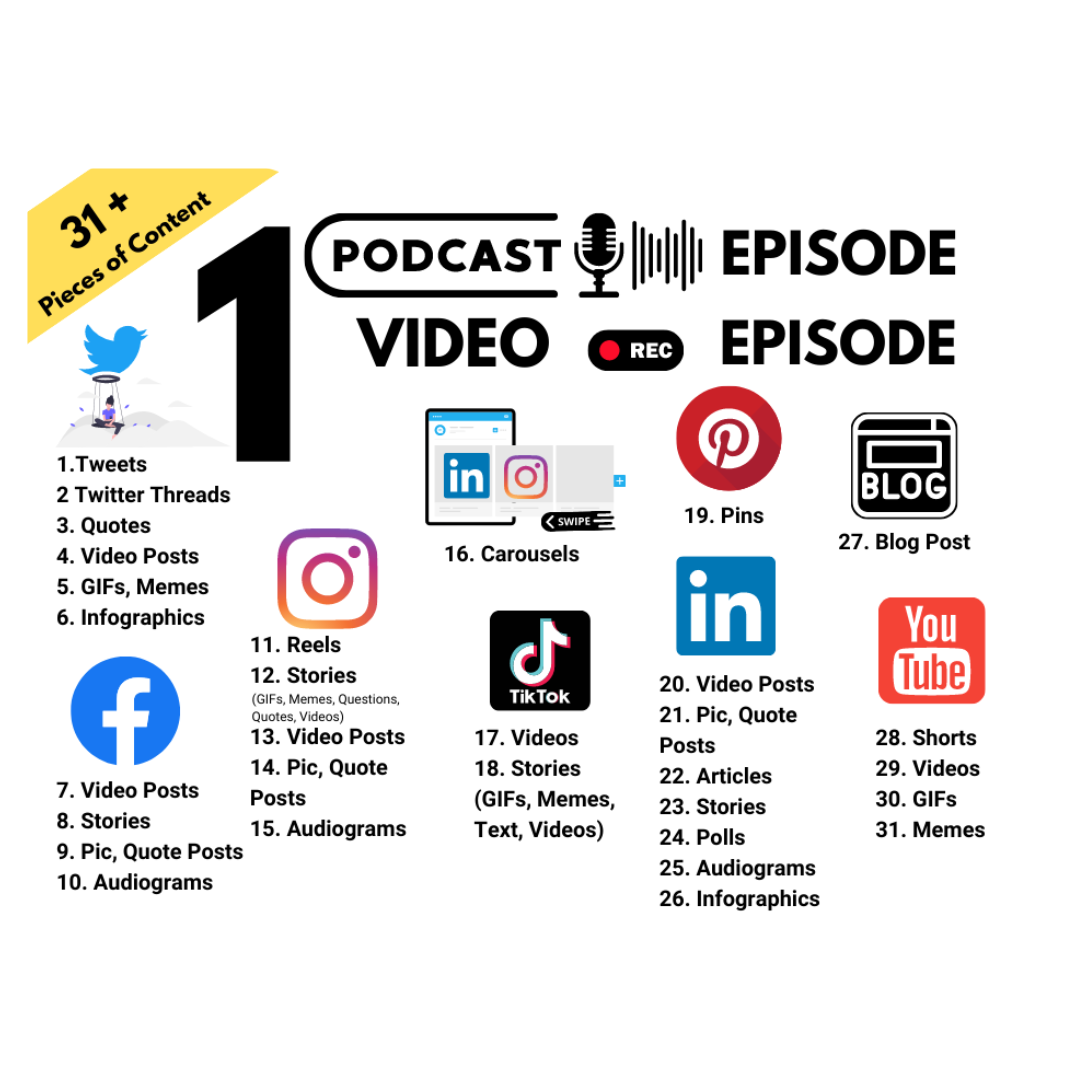What is an example of repurposing content on social media, you ask?
Are you a small business owner or entrepreneur attempting to maximize your online presence and wondering how to repurpose content to social media posts?
Repurposing content for social media can feel like navigating uncharted territory. It’s not just about recycling old posts – it’s much more!
This strategy involves transforming your existing high-quality blogs, podcasts, and videos into formats that suit various platforms. That way, you get the most out of your creation.
The beauty of repurposing? You save time and resources while expanding your reach to new audiences who may prefer one type of content over another.
But here’s the kicker…
If done right, this approach isn’t just practical; it can significantly boost your SEO efforts! So, let’s dig in.
Table Of Contents:
- Unveiling the Power of Optimizing Content
- The Perks of Amplifying Your Content
- Strategies for Effective Content Repurposing
- Breathing New Life Into Older Content
- Implementing Your Content Repurposing Plan
- Real-life Success Stories of Content Repurposing
- FAQs in Relation to What is an Example of Repurposing Content on Social Media
- Conclusion
Unveiling the Power of Optimizing Content
If you’re acquainted with content marketing, repurposing should be a familiar concept. But what does it really mean?
Well, imagine taking a piece of high-quality content you’ve already crafted and presenting golden nuggets from that piece into different content forms to publish on various social media platforms.
This isn’t just spinning old ideas.
It’s about squeezing maximum value from your original creations by extending their reach on social networks and blogging platforms. For instance, an insightful blog post can be reimagined into a captivating podcast episode or even transformed into an eye-catching article on LinkedIn.
This strategy is nothing short of gold in today’s fast-paced digital world, where small business owners constantly multitask. By leveraging existing quality content through practical repurposing efforts, they save time on content creation while continuing to deliver valuable information across diverse mediums to their audience.
The beauty in creating content when amplifying content lies in diversity – each format appeals differently within your target demographic due to varying preferences for consuming information.
Some folks might prefer reading long-form blog posts during coffee breaks; others could enjoy podcasts during commutes; some may favor quick video clips on social network feeds between work sessions.
Repurposing content means taking the different formats, extending the lifespan, and amplifying opportunities for engagement with varied groups within the potential customer base.
The Perks of Amplifying Your Content
Amplifying your content is a smart move for small business owners.
It’s all about getting the most bang for your buck with already-existing top-notch material while conserving energy and assets.
Boosting SEO with Content Repurposing
One significant benefit of repurposing content is its potential to improve your SEO.
Creating new versions of your existing content opens up keyword research and optimization opportunities, which can lead to better search engine rankings.
It’s essential to cater to different preferences.
Some visual learners prefer infographics and videos, while others enjoy in-depth blog posts or podcasts. Presenting information in multiple formats increases the chances of reaching and engaging a wider audience.
Establishing Niche Authority through Content Repurposing
Becoming a trusted authority in your field isn’t just about knowledge; consistency also plays a role.
Regularly providing valuable insights across various platforms reinforces your credibility with clients and peers over time.
Repurposing can also help address common questions or challenges within your niche, building trust with your audience and positioning yourself as their solution source.
Another wonderful way to establish your niche authority is to repost social media content that you believe will be helpful to your audience but also complement your content strategy.
In essence, strategic content optimization allows you to establish yourself as an industry leader without constantly creating new content.
Strategies for Effective Content Repurposing
Optimizing content involves modifying existing content to fit various formats, mainly focusing on extended blog articles.
So, what is an example of repurposing on social networks?
Long-form blog posts can be a fantastic focus of your content optimization efforts.
Transforming Blog Posts into Social Media Content
When considering optimizing content, a great place to start is by turning your detailed blog posts into bite-sized social media snippets.
Pull out golden gems or intriguing quotes that will pique the interest of your followers across various social networks.
Keep in mind that each platform has its unique audience and format requirements.
Instagram users might respond better to visually stimulating images and Reels, while X (Twitter’s) or Threads user base may appreciate short, punchy, yet impactful messages.
Leveraging Webinars and Videos
You’re sitting on a goldmine if you’ve hosted webinars or created informative videos as part of your marketing efforts.
Short clips from these longer forms make excellent shareable material for social media shares.
You can also create summaries highlighting essential takeaways from these sessions and post them on popular blogging platforms such as WordPress or Blogger for an SEO boost.
Maximizing Podcasts’ Potential
Podcasts, although primarily audio-only mediums offer ample opportunities for content-optimizing strategies.
When podcasting, why not turn it into a video podcast?
Next, you can transcribe entire podcast episodes into comprehensive blog posts, providing high-quality written information alongside their original auditory counterparts.
Potentially influential quotes from guest speakers during interviews are perfect fodder for infographics shared widely over multiple channels, expanding reach beyond those who prefer listening rather than reading.
Breathing New Life Into Older Content
When optimizing content, updating older posts is a clever tactic.
It’s not merely about keeping your information up-to-date; it also involves injecting fresh perspectives or insights into the mix.
Plus, SEO will love you.
Refreshing Evergreen Blog Posts
The term ‘evergreen’ refers to blog posts that stay relevant over time due to their timeless subject matter. But even these can benefit from an occasional refresh.
You might be thinking – how does this tie in with content optimization?
By updating evergreen blogs, you’re essentially creating new value without starting from scratch.
This could involve adding recent data or developments related to the field, enhancing the original post, and making it more appealing for today’s audience.
Remember: The goal isn’t just recycling but enhancing what already exists.
Tweaking Outdated Material
Sometimes, existing articles may have outdated references or statistics that need tweaking. A few minor changes can breathe life back into such pieces.
No one wants to waste their time on old statistics.
The trick lies in identifying parts of the article needing revisiting – perhaps certain sections are no longer accurate due to industry advancements, or there’s newer research available now than when you first published.
Remember: Your aim should always be enhancement rather than mere recycling.
Implementing Your Content Repurposing Plan
A well-executed repurposing plan starts with identifying your top-performing pieces.
These gems have resonated with your audience and can be reworked to engage even more people.
Why reinvent the wheel when a piece of content is working well?
Choosing Suitable Platforms
Picking the right platforms for reposting is crucial in your marketing.
Not all social networks will do justice to your valuable content. Each platform has its unique user base and behaviors, which should align with your target audience.
Recent demographic insights, for instance, reveal that Instagram users skew younger, while LinkedIn attracts professionals across different age groups.
So, repurposing visual content like infographics on Instagram might be effective if you’re trying to connect with millennials or Gen Z consumers.
If you’re targeting business professionals, consider breaking down long-form blog posts into bite-sized articles or discussion post points suitable for LinkedIn’s audience.
Remember, it’s not just about making great content but also guaranteeing it arrives at the right people.
In addition to considering demographics and preferences, think about how each platform handles different types of media – text updates, image-heavy posts, video snippets, etc. This understanding can guide you in determining the best format for repurposing your content on each platform.
Your goal is to leverage existing high-quality content through strategic repurposing efforts, just like successful businesses have done (and I’ll share some of these stories later.). Stay tuned.
Real-life Success Stories of Content Repurposing
Content optimizing can seem challenging, but when done right, it is an effective strategy to maximize your existing high-quality content.
Let’s explore examples of companies that have optimized content successfully.
The HubSpot Transformation
You’ve probably heard about HubSpot and its top-notch blogs and webinars.
What you might not know is how they masterfully repurpose these into comprehensive guides or eBooks.
This ingenious method extends their content’s life cycle while expanding its reach to those who prefer long-form reading.
A classic case in point: Buffer’s social media playbook was initially created as internal documentation before being transformed into an extensive guide on social media strategies – showcasing how valuable internal resources can be converted into public-facing material through strategic planning and execution.
Moz Whiteboard Friday Series Magic
Another shining example comes from Moz’s “Whiteboard Friday” series – video lectures transcribed meticulously into detailed blog posts for an SEO boost.
The genius behind this form of content optimizing means taking one format (video) and turning it into another (text), maximizing potential reach by appealing to visual learners and avid readers alike.
Gary Vaynerchuk’s Pyramid Model Mastery
Digital marketing guru Gary Vaynerchuk employs what he calls his ‘content pyramid model.’
Starting with pillar pieces such as keynote speeches or podcast episodes broken down further;
– quotes for Instagram here,
– sound bites for Twitter there.
It goes without saying that small business owners could learn a thing or two from Mr. Vee about leveraging every bit of available material through smart planning.
FAQs in Relation to What is an Example of Repurposing Content on Social Media
What does it mean to repurpose content?
Content repurposing means presenting existing material in different formats or platforms to maximize its value and reach.
How do you repurpose content on Instagram?
You can turn blog excerpts into engaging captions, create infographics from data-driven posts, or share short video clips from webinars on Instagram Stories.
What is media repurposing?
Media repurposing involves reformatting one type of media – like a podcast episode – into another form, such as a blog post or social media posts update. It extends the use and impact of your original creation.
Conclusion
Repurposing content on social media is a game-changer, and there are always new ways to repurpose your existing content. It’s truly about breathing new life into your existing high-quality material, not just repeating or stealing like an artist.
By repurposing existing content, you can save time and resources, particularly if you’re a small business without the benefit of dedicated content creators.
It also opens up opportunities for SEO optimization and establishing authority in your niche. Imagine being recognized as an expert because you consistently provide valuable information across multiple platforms!
The best part? You have numerous ways to repurpose different types of content – from transforming blog posts into engaging social media snippets to leveraging webinars, videos, and podcasts.
Even older content isn’t left behind; evergreen topics always welcome fresh insights or perspectives. And with strategic planning, this could all be within your reach.
If this sounds exciting but overwhelming at the same time – don’t worry! We can take the content game off your plate. Ready to harness the power of repurposing?


.png)







